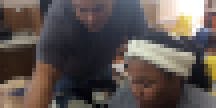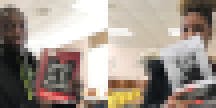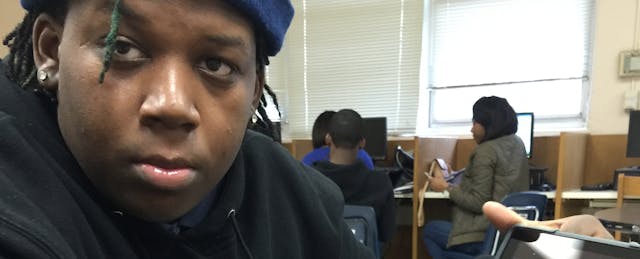A friend of mine jokingly refers to me a “Pryzbylewski,” referring to the cop-turned-teacher in “The Wire” who develops a strong relationship with the middle schoolers in his class—many of whom are affiliated with gangs. I’m an ex-cop and I’ve got strong relationships with my students, but I don’t see that as a big accomplishment.
Over the last few years my classroom has gotten a lot of attention. People have noticed that I’m strengthening relationships with my students, I’ve designed a curriculum that’s engaging for the toughest kids, and I’m using the iPads I found in a corner. They say I’m personalizing learning. I’ve received awards and grants—which is great, but the reality is that the way I teach came out of dire circumstances for my students.
I came to the Cobb County School District in 2006. My boss at the time, who brought me into education, told me not to worry. I was teaching special education, and my students would have behavior problems but it was nothing I couldn’t handle.
I was mistaken. Apathy was everywhere. I asked my students to take out their workbooks and turn the page—I got dead eyes and gum chewing. I tried to tell a story about myself and make it funny—nothing. When the bell finally rang, I sprang out to the hallway to fulfill my hall monitor duty. If teaching wasn’t the explosion of learning I thought it was going to be, at least I could make my bosses happy.
I couldn’t blame the kids. With the racial and socioeconomic divide right in front of them, how should they behave? Advanced placement students, in mostly white classes, were actively engaged and sitting in circles. Our classrooms were chaotic—everyone sitting in disarray. The department head forced me to use the same texts used in every other English class—so there I was, in a room full of black kids reading the whitest things ever written. Defeat was built into the expectations of the special education classroom, and it was hard for me to see any viable escape.
In 2012 I took a job as a general education language arts teacher, working with at-risk youths. It was a better fit for me than “behavior problem troubleshooter and paperwork expert.” There was no question that education in Georgia was systemically racist and corrupt, if you looked like a football coach you were going to babysit problem children, not teach American Literature to engaged students. A chance to to break that mold presented itself. It wasn’t “Dead Poets Society” but it could possibly be “Dangerous Minds,” so I leapt at it.
In 2012, I transferred to McClarin Success Academy in Fulton County School District. The high school is in College Park, Georgia which, according to FBI crime statistics, is the fifth most violent city in the United States. My students had all failed out of general education and come to this alternative school for a second chance. The curriculum they were exposed to had already proven itself ineffective—but I didn’t have access to anything better.
I was in a blended classroom where my role had shifted from teacher to facilitator, and the expectation was to use Edgenuity, an online curriculum program, but it wasn’t working. The online program was dated and completely irrelevant to today’s times. Then there was the student body itself. We knew traditional school had failed them, yet most teachers were still using traditional disciplinary practices. It was an endless cycle and I wanted no part of it.
Rules are important, I won’t deny that. But at the police academy they teach you about discretion so I brought that to my teaching. I made certain that trivial things like food, music and swearing weren't penalized. I’m not in a position to tell you that you can’t eat. If you’re starving and you need to eat, you should. People swear, such is life. Students get work done when they listen to music, so be it. The students started seeing me as an outcast; they didn’t consider me like the other teachers—you could swear around me and I let you eat—and in a way, they felt respected. The success I’ve had with students started here, when our relationship began to change.

The Evolution of Technology
We spent a lot of money on devices that we didn’t know how to use. I found out we had a cart full of 40 iPads in a closet purchased with school improvement money. I wanted to go paperless so we could keep track of work—so my students never had to panic about forgetting a pen, a pencil or a backpack again. So I took the iPads while no one was looking.
I started using Google Classroom to post all of my content online, and provide feedback on assignments. Getting on the cloud solved some of our problems, but others remained and new ones emerged. The most critical issue was always the learning gaps. My 16, 17 and 18-year old students were entering my class reading at an elementary level. In some cases, students could read at a very advanced level but had shut down because the traditional curriculum wasn’t relevant.
Going paperless wouldn’t solve this problem. I decided to learn everything I could about mastery-based assessments so that I could start to close the learning gaps. I had long wondered what an "A" was really worth. Students who got most of the recall questions wrong, but did brilliantly on their essays, were still failing, which was inherently unfair. Mastery-based assessment directly addressed this issue. By tailoring assessments to specific standards and breaking them down to show students what was mastered and where they needed to improve, I was able to shine a spotlight on areas where each student was excelling.
After shifting to mastery-based assessment, the next logical step was 1:1 instruction. Many of my students refused to participate in any kind of group work, but all of them responded to individual attention, so the curriculum had to be designed to maximize the opportunity for one-on-one time with me.
This started with a pre-test, many of which are available via online programs with one huge caveat: assigning a generic pre-test is a waste of time. It’s critical to look at the standards and to identify what determines mastery for each one. Using USATestprep, an online assessment tool, I built diagnostics from scratch to shift the focus from what students didn’t know to what they did. This is how I made inroads—putting as much work into curriculum as I expected them to put into it.
Constantly monitoring student progress from formal and informal assessments, and holding daily 1:1 work sessions and conferencing with students, I started to notice trends. I was able to design differentiated curriculum in three tiers and distribute content pretty easily. But there were always one or two students who required something more—an entirely different curriculum. Either they were so advanced and needed a challenge, or they struggled and needed more support. I switched from Google Classroom to OneNote Classroom, which made it easier for me to distribute content individually.
As far as reading material, I was fortunate enough to end up on a district team that defined standards and curriculum for the entire district. But there were no specific texts that all classes were beholden to. That freedom was pivotal for us.
With the chains off, I gathered a group of students and we started hashing out book lists, with the condition I had final approval. We tried to stick to award winning books but slipped in the occasional graphic novel or political theory book to shake things up. There was money available to purchase books, and we essentially had carte blanche to build our own library. Instead of “The Great Gatsby,” “Romeo and Juliet” and “The Hunger Games,” we had “The Watchmen,” “Nat Turner” and “Blues for Mr. Charlie.” With our new library and revamped curriculum, a strong blended model and our online distribution platform, we started making serious progress both academically and emotionally.

Results that Captured Attention
Academically, the Georgia Milestone scores in American Literature almost doubled from 2015 to 2016, moving from 24% to 44%, and we more than doubled the amount of students who actually took it. More importantly, students were engaged and talking.
In 2012, the way I was teaching didn’t have a name. Peers and administrators would observe my class and say, “everyone just plays around on iPads.” Today, we call it personalized learning, and my peers and administrators say, “I’m not sure what is happening but his test scores are great.”
Personalized learning is the new buzzword—edtech companies are after it and teachers toss it around as often as possible. The term, when generated from student needs, can be a great thing. What should never be underestimated though, is the amount of continuous work that goes into it. Getting set up is one thing, but consistently monitoring student data, providing feedback, and adjusting curriculum is ongoing.
At the end of the day I’ve created a personalizing learning environment. I wish I could say all my students are on a clear path to success, but no amount of technology can overcome the systemic hurdles they face outside of school. In a way it still plays out like that last episode of “The Wire.” One kids becomes Bubbles, one kid becomes Omar, the child with the most support goes on to college. It’s a cycle, I know where they’re all going. Sometimes it doesn’t matter how hard you work, you can’t overcome someone’s situation. That’s the worst thing about coming into work everyday.
Institutional racism runs deep in the Atlanta Metro area. I’m getting to the point where white people are noticing me and offering me “more desirable” teaching positions, but I can’t leave for the chance of 100% more bureaucracy and $5K more a year. No one will work with these kids if I leave. I think I’ve created something important but it still points out flaws in the system that won’t be fixed unless things change across society, not just education.
Farhat Ahmad is a 9th and 10th grade World, Multi, and American Literature teacher at McClarin Success Academy in College Park, Georgia.


